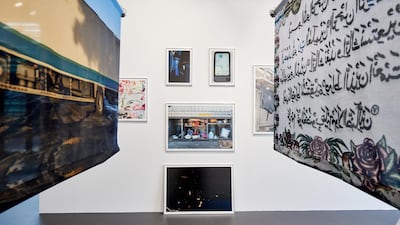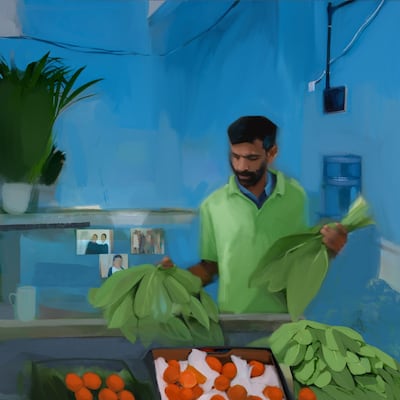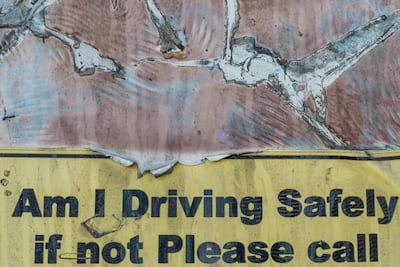Mina Zayed is no longer what it was, and it’s not yet what it is intended to be. It lives, as photographer Finn-Murray Jones describes it in an essay, in “suspended existence”, hovering between its past as a key trading port and its future as a commercial and tourism hub.
In the Warehouse421 exhibition Mina Zayed: Reflections on Past Futures, 11 artists explore this liminal state, the port’s surrounding infrastructure and the communities that give life to the neighbourhood. At the heart of the show is the examination of place – how it is created, recreated and defined, and by whom.
Reflections on Past Futures is the result of a mentorship programme that began in February last year and is run by Warehouse421 and Dubai’s Gulf Photo Plus. Over the past year, the artists have explored Mina Zayed to develop their projects and have worked with mentors from both institutions to exhibit them.
Some works, such as Catherine Donaldson’s Museum of Ordinary Things, seek to memorialise the area. Her installation features objects collected from Mina Zayed’s markets such as blankets, baskets, mops and boxes, which have been turned into artefacts for the exhibition. Meticulously arranged, hung and shown on plinths, they replicate museological displays.
“I wanted to comment on the roles that museums play in deciding what is culturally meaningful,” Donaldson says.
But the objects are superfluous next to the gems of the work – illustrated portraits of fruit and vegetable sellers, whose stories Donaldson highlights with snippets of her conversations with them. Compared to the curation of mass-produced items, these images reveal a more emotive, subjective view of the artist’s experience.
The work of Lena Kassicieh titled Postcards from Mina Zayed mirrors Museum of Ordinary Things in its desire to preserve a place materially.
Kassicieh transforms her photographs of the area’s industrial sights into bright, pastel-coloured postcards, questioning how aesthetic value is imposed on urban landmarks and attractions.
For Fatema Al Fardan, the value of a neighbourhood is more subjective. In her diaristic photo series We Dance Asynchronously on the Same Stage, Al Fardan considers place as personal memory. Through text and image, she excavates her childhood recollections of Mina Zayed, incorporating herself and her family into the work.
“I wanted to tell a UAE story, to understand what happens to our narratives when spaces, like Mina Zayed, that seem so intertwined into our fabric, are dismantled,” she explains.

Al Fardan photographs herself among the construction rubble and the emptied warehouses of the area. In one image, she even recreates a recurring scene from her younger years with her mother and sister – when her father would buy produce from Mina Zayed’s fruit and vegetable market as the family waited in the car.
Both Donaldson and Al Fardan cast their perspectives towards the past, or at least a fading present, emphasising the role of lived experience in shaping a place.
Artists such as Lateefa Almazrooei and Sandra Zarneshan, on the other hand, focus on the changing built environment. Their images intimately examine the shift that has been happening to Mina Zayed since 2012. Its once-bustling spaces, including markets, a wedding hall, toy store and an arcade have diminished or disappeared entirely.

Almazrooei’s Seeking features Mina Zayed’s abandoned warehouses and buildings. At first, the series of meditative videos appear to be photographs, until flashes of movement, a bird in flight or branches swaying to the breeze, reveal otherwise. Zarneshan’s photographs are more about visual play, capturing oddities and symmetries – shadows perfectly framing a pair of gloves on a laundry line, for example – scattered around the area.
The artists’ images are visual representations of bated breath; the structures will soon be paved over as Mina Zayed enters a more transformative phase. Following the demolition of Mina Plaza Towers last year, the neighbourhood now awaits the arrival of a high-end residential and retail development.
Despite the debris and the vacant lots, communities still thrive in Mina Zayed. Augustine Paredes turns his lens to the delivery truck drivers who journey between Saudi Arabia, Jordan and the UAE, transporting fruits and vegetables across borders.
Named after the ubiquitous sticker found on truck bumpers, the project Am I Driving Safely? Please Call reveals how the drivers turn their vehicles into homes, with makeshift beds and kitchens, but also how lives are reshaped by commerce and globalisation.
Mazna Almazrouei’s series of monochromatic film photos titled Mina Repurposed focuses on a group of men who gather to play cricket every Friday.
“Their locations on empty streets between the warehouses or in the ship graveyard presented a unique opportunity where I could show parts of Mina some recognisable to outsiders, others only known to the players,” Almazrouei says.
She had intended to create a more nostalgic project about her own relationship to the neighbourhood when she discovered the team.
“I noticed that the areas in Mina Zayed that are otherwise abandoned and forgotten are brought back to life by groups of men playing cricket … All are city dwellers and visit Mina on their day off to find an escape from their stressful jobs and daily life,” she says.
Perhaps the most forward-looking work in the exhibition, and the only one that has an environmental viewpoint, is Lara Rudar’s The Dhow Graveyard, which includes photographs of the many splintered vessels around Mina Zayed, but also presents a virtual-reality environment where these dhows could be integrated under the sea. Rudar imagines the vessels as repurposed into artificial reefs, in the same way some shipwrecks do.

Reflections on Past Futures is not a dirge for a neighbourhood in decline – the time has passed for that. Neither does it drive the promise of urban progress, since the area’s redevelopment is part of an inevitable global trend. Instead, it acts as a resistance to forgetting.
Once Mina Zayed is cleared of rubble, new structures of concrete and glass will be erected, new narratives will emerge, and it will be all too easy to forget this period of suspension before the tide of change takes over. Thankfully, the artworks will remain.
An artist talk for Mina Zayed: Reflections on Past Futures will take place on Tuesday, February 16 via Zoom from 7pm-9pm. The exhibition will run until Sunday, June 13. More information is available at warehouse421.ae





